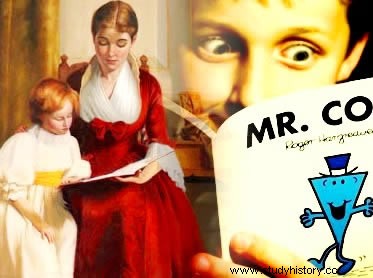
A famous popular saying advises us never to judge a book by its cover. However, in the world of children's literature this maxim cannot be taken literally. After all, the current competition over this “small” audience encourages publishers to seek ever more creative and innovative solutions. In addition, the first literary memories of this same audience are usually accompanied by the immediate visualization of their favorite heroes, villains and characters.
Before lines and colors brought Little Red Riding Hood's clothes to life, children's literature suffered from the restrictions of 16th century graphic technology. The first works of this genre were sold by street vendors who reproduced folktales in so-called “chapbooks”. These first children's books were made from a huge sheet of paper folded into a dozen parts and lacking any illustrated presentation.
Only in the 18th century, thanks to the interest of the merchant and illustrator John Newbery, the history of children's books had a new page. Around 1740, this Briton had the idea of making illustrations for a children's book. Soon after, he decided to increase the visual appeal of the books he sold by adding a toy. In a short time, Newbewrry reinvented the children's literary market and captivated the memory of young readers.
Moving on to the 19th century, we see the covers gain a greater wealth of detail with the use of colorful prints and details in metallic tones. In the same period, we have the creation of attractive toy books and gift books. Among the classics of that time we can point out the publication of “Alice in Wonderland”, by Lewis Caroll; and “Fairy Tales for Children” by the Brothers Grimm. In the 20th century, falling costs and technological advances gave more life to children's covers.
The economic crisis that befell the world with the two World Wars, caused the children's literature market to suffer a great retraction. The United States, the most stable of economic powers, dominated children's literature for a long time and was able to attract many foreign authors. With the end of the Second World War, the wave of technological innovations promoted the creation of several stories and illustrations where machines and automobiles came to life.
In the 1960s and 1970s, the hippie movement and the revolution in values had a direct impact on the production of these works. The stories had increasingly existentialist traits and the covers gained a greater range of colors and shapes. One of the best sellers that represented this trend was the book “Charlie and the Chocolate Factory”, where a poor boy was torn between his personal dreams and the economic problems of his family.
In the following decade, the children's publishing market was largely consolidated and investment in computer graphics technology was taking its first steps. At the same time, illustrations gained greater strength with the innovative manufacture of books aimed at babies. At the end of this century, this field took a bigger step with the worldwide fame of Harry Potter, the enigmatic English wizard capable of attracting the imagination of adults and children alike.
With this, we realize that the graphic art of children's literature marked the development of an economic market. The creative action of the illustrators and the printing technology were responsible for the formation of a playful memory shared by thousands of people who knew Oliver Twist, Barbar the elephant, Snow White and other children's icons.
